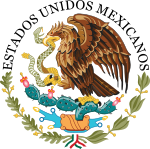Coat of arms of Mexico
| Coat of arms of Mexico Escudo Nacional de México |
|
|---|---|
 |
|
| Versions | |

Seal
|
|

Black and white version of the seal
|
|
| Details | |
| Armiger | United Mexican States |
| Adopted | 16 September 1968 (latest version, by Francisco Eppens Helguera) |
| Escutcheon | Atop a nopal pedestal, a Mexican golden eagle devouring a rattle snake |
| Supporters | Oak and laurel leaves |
The current coat of arms of Mexico (Spanish: Escudo Nacional de México, literally "national shield of Mexico") has been an important symbol of Mexican politics and culture for centuries. The coat of arms depicts a Mexican golden eagle perched on a prickly pear cactus devouring a rattlesnake. To the people of Tenochtitlan this would have strong religious connotations, but to the Europeans, it would come to symbolize the triumph of good over evil (with the snake sometimes representative of the serpent in the Garden of Eden).
The Seal of the United Mexican States is the seal used by the government of Mexico in any official documents issued by the federal, state or municipal authorities. It is a modified version of the national coat of arms, with the addition of the full official name of the country Estados Unidos Mexicanos, in a semi-circular accommodation in the upper part of the seal. Current and past Mexican peso coinage have had the seal engraved on the obverse of all denominations.The Mexican coat of arms is very important to the people of Mexico.
The coat of arms recalls the founding of Mexico City, then called Tenochtitlan. The legend of Tenochtitlan as shown in the original Mexica codices, paintings, and post-Cortesian codices, does not include a snake. While the Fejérváry-Mayer codex depicts an eagle attacking a snake, other Mexica illustrations, such as the Codex Mendoza, show only an eagle; in the text of the Ramírez Codex, however, Huitzilopochtli asked the Tenochtitlan people to look for an eagle devouring a snake, perched on an prickly pear cactus. In the text by Chimalpahin Cuauhtlehuanitzin, the eagle is devouring something, but it is not mentioned what it is. Still other versions (such as the backside of the Teocalli of the Sacred War) show the eagle clutching the Aztec symbol of war, the Atl-Tlachinolli glyph, or "burning water".
...
Wikipedia
